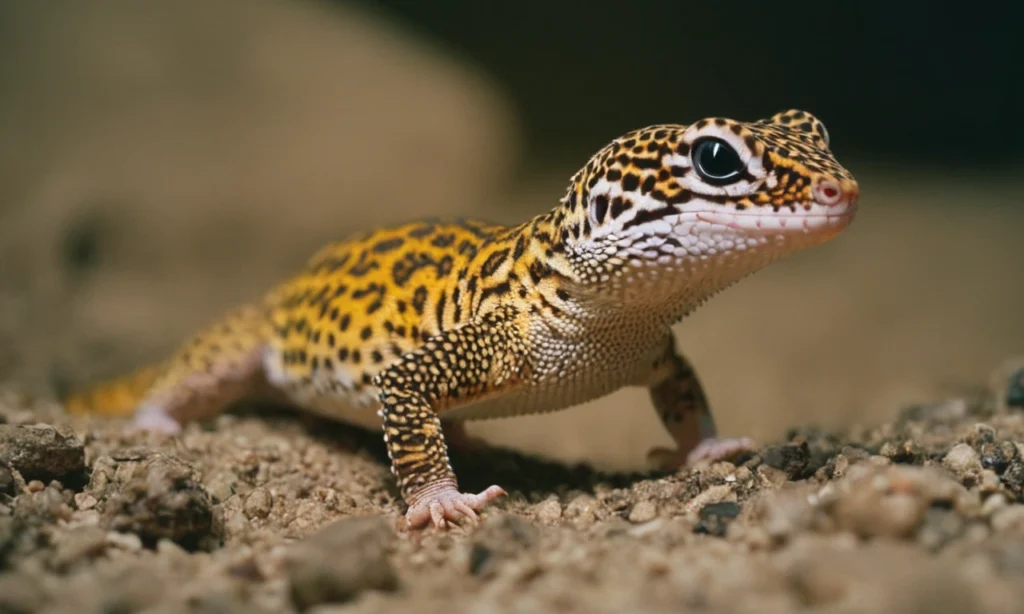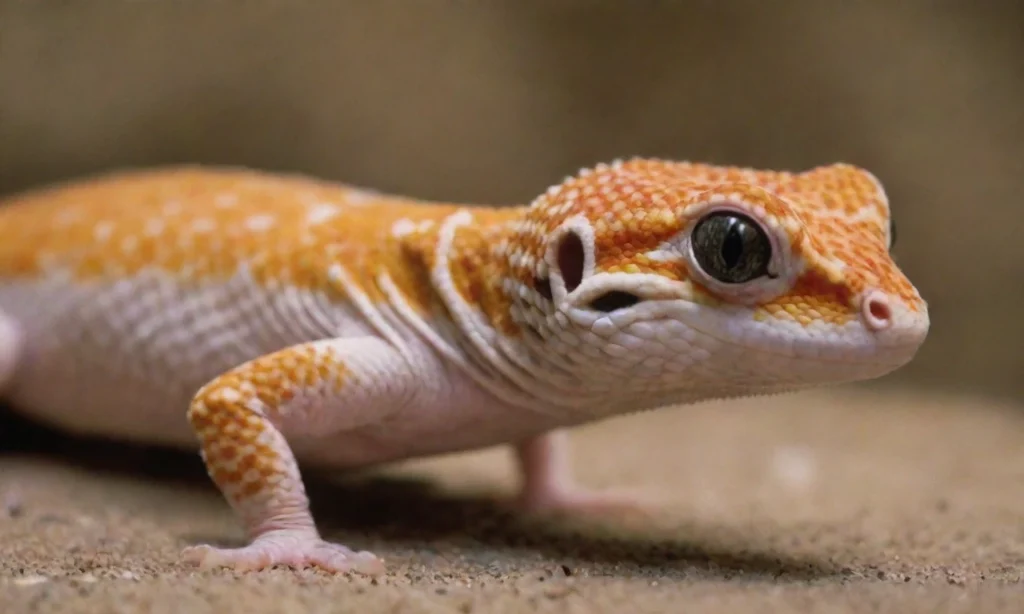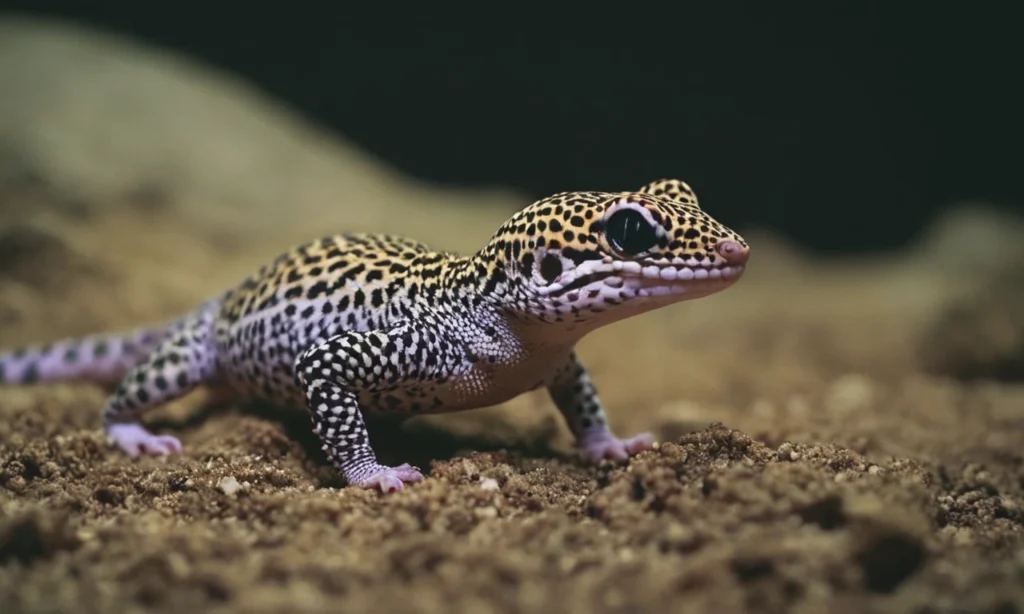Leopard gecko ears have a surprising “see-through” quality. Learn about their fascinating ear anatomy, incredible hearing abilities, and how to keep those ears in top shape.
Leopard Gecko Ear Anatomy

Leopard geckos may look like they simply have small ear holes on the sides of their head, but there’s a fascinating and complex structure hidden beneath the surface. Understanding their ear anatomy is the first step to ensuring good ear health for your reptile companion.
External Ear
The most obvious part of a leopard gecko’s ear is the external opening, also known as the ear canal. It’s a small, slightly oval-shaped hole located just behind the eye. Unlike mammals, they don’t have external ear flaps (pinnae). This streamlined design helps them move easily through their natural habitat and avoids snagging on rocks or vegetation.
The ‘See-Through’ Ear
Some people say that leopard gecko ears are ‘see-through.’ This is because the eardrum (eardrum) is very close to the skin’s surface. The eardrum is a thin, semi-transparent sheet of tissue that vibrates in response to sound waves. In some leopard geckos, you might even be able to visualize the outline of the columella bone just beneath the eardrum.
Middle Ear
Just behind the eardrum lies the middle ear, an air-filled cavity. This cavity contains a single bone called the columella (equivalent to the three bones in a human middle ear). The columella transmits vibrations from the eardrum to the inner ear. It has a unique structure with several projections that help with sound amplification.
Inner Ear
The inner ear of a leopard gecko is where the magic of hearing truly happens. It houses the cochlea, a spiral-shaped organ filled with fluid and tiny hair cells. These hair cells translate vibrations into electrical signals that are sent to the brain, where they are interpreted as sound. The inner ear is also responsible for balance and orientation, essential for these agile lizards.
The Jaw Connection
One unique aspect of leopard gecko ear anatomy is the connection to their jawbone. The columella is attached to the quadrate bone, part of their jaw structure. This connection amplifies vibrations and enhances their sensitivity to low-frequency sounds. This adaptation is particularly helpful in their desert environment, where detecting the subtle movements of prey is critical for survival.
Leopard Gecko Ears – Designed for Survival
The intricate structure of leopard gecko ears is a marvel of evolution. Their hearing plays a crucial role in,
Prey Detection: They can pick up on the faintest sounds of insects moving, even in the dark. This nocturnal hunting advantage is crucial for their success.
Predator Avoidance: Sensitive hearing helps them detect approaching threats, giving them precious time to escape or hide.
Communication: While limited, leopard geckos may use some vocalizations like chirps and squeaks, and their hearing helps them interpret sounds from other geckos.

How Leopard Geckos Hear
The ear structures of a leopard gecko might be tiny, but they pack a powerful punch. Let’s break down the step-by-step process of how they translate vibrations in the air into recognizable sounds.
1. Sound Waves Enter the Ear
Sound travels in waves. When these waves reach a leopard gecko’s head, they are funneled into the external ear opening. Since they lack external ear flaps, their ear canals are always open and receptive to sounds in the environment.
2. Eardrum Vibration
The sound waves cause the eardrum (eardrum) to vibrate. The strength and frequency of sound waves affect the pattern of these vibrations.
3. Transmission Through the Middle Ear
The single bone in the middle ear, the columella, picks up the vibrations from the eardrum. Its unique shape and attachment to the jawbone help amplify these vibrations, especially those of low frequencies that are important for detecting prey and predators.
4. The Inner Ear’s Magic
The vibrations travel into the fluid-filled cochlea in the inner ear. Tiny hair cells within the cochlea move in response to the vibrations. This movement generates electrical signals.
5. The Brain’s Interpretation
The electrical signals are carried by the auditory nerve to the leopard gecko’s brain. The brain processes these signals, interpreting them as specific sounds. This allows the gecko to identify the type of sound, its volume, and its general location.
Leopard Gecko Hearing Capabilities
Frequency Range: Leopard geckos are most sensitive to low-frequency sounds, which are helpful for their survival needs. While their exact hearing range is debated, it’s likely narrower than that of humans.
Directional Hearing: Their ear placement and jaw connection give them some ability to determine the direction of a sound. This helps them locate prey or avoid approaching danger.
Nocturnal Advantage: Leopard geckos’ hearing is well-adapted to their nocturnal lifestyle. They can pick up on the faintest sounds of insects moving in low-light conditions, giving them a hunting edge.

Ear Care and Common Health Problems
While leopard geckos have evolved to have resilient ears, sometimes problems can arise. Understanding proper ear care, recognizing signs of trouble, and knowing when to seek veterinary help are essential for any responsible leopard gecko owner.
Ear Cleaning – When and How
Leopard geckos are generally capable of keeping their ears clean on their own. In most cases, you should not attempt to clean their ear canals yourself. Introducing liquids or cotton swabs into their ears can cause irritation or even damage.
However, there are a few exceptions:
Shedding Issues: If a piece of shed skin blocks the ear opening, you can gently assist its removal with a dampened cotton swab. Use extreme caution and never poke anything inside their ear.
Veterinarian’s Recommendation: If your veterinarian diagnoses an ear issue, they may provide specific cleaning instructions and medications. Always follow their advice closely.
Signs of Ear Problems
Monitor your leopard gecko’s behavior and ear appearance for these potential signs of trouble,
Discharge: Any fluid, pus, blood, or unusual odor coming from the ear.
Swelling or Redness: Around the ear opening or affecting the side of the head.
Head Tilting: A persistent head tilt could indicate an ear infection or damage to the inner ear.
Loss of Balance: Severe inner ear problems can disrupt balance and coordination.
Decreased Appetite or Lethargy: General signs of illness that could be related to an ear infection, impacting their overall wellbeing.
Scratching or Rubbing: Your gecko may try to scratch at their ear or rub their head against objects if there’s irritation.
Common Ear Health Issues
Ear Infections: Caused by bacteria, fungi, or parasites. Symptoms may include discharge, odor, swelling, discomfort, and even behavioral changes.
Ear Mites: Tiny parasites that can infest the ear canal, causing intense itching, dark-colored debris, and inflammation.
Impaction: A buildup of debris, shed skin, or foreign objects that blocks the ear canal. This can lead to discomfort and predispose them to infections.
Abscesses: Pus-filled pockets of infection that can form near the ear in severe cases. These may require surgical drainage and antibiotics.
Injuries: While less common, leopard geckos may occasionally injure their ears due to altercations with other geckos or accidents in their enclosure.
When to See a Veterinarian
If you notice any signs of ear problems in your leopard gecko, don’t delay in seeking veterinary care. A qualified reptile veterinarian can diagnose the issue, determine the underlying cause, and provide appropriate treatment. Prompt treatment is important to prevent complications, ensure your gecko’s well-being, and minimize the risk of hearing loss.

Fun Facts About Leopard Gecko Ears
Beyond their importance for survival, leopard gecko ears have some quirky and fascinating features that make them even more amazing.
Defensive Puff-Up
When startled or threatened, leopard geckos can slightly inflate the area around their ears. This makes them look a bit larger and might deter potential predators.
The “See-Through” Illusion
The thinness and transparency of their eardrum sometimes give the illusion that you can see right through their head!
Ear Holes as Eye Helpers
Leopard geckos lack eyelids. They use their tongue to clean and moisten their eyes. However, they can also retract their eyes slightly and use the inside of their ears to help remove dust or debris.
Nocturnal Advantage
Leopard geckos’ ears are perfectly adapted to their nocturnal lifestyle. Their sensitivity to low-frequency sounds allows them to pick up on the faintest movements of insects in the dark, giving them a hunting edge.
Ear Wiggles?
Some owners report seeing their leopard geckos seemingly wiggle their ears slightly. While not fully understood, this might be a way to help dislodge tiny debris or adjust pressure within their ears.
Sound Localization Specialists
While their directional hearing isn’t as precise as some animals, leopard geckos can determine the general direction a sound comes from. This helps them quickly locate prey or identify potential threats.
Unique Among Lizards
Not all lizard species have external ear openings. Leopard geckos, along with some other gecko species, are unique in this visible ear structure.

Myths and Misconceptions
Like many aspects of animal biology, there’s some misinformation floating around about leopard gecko ears. Let’s clear things up!
Myth: They can hear through their jaws.
Fact: While the jawbone connection amplifies sound, leopard geckos don’t actually perceive sound through their jaws. Their ears are still the primary sensory organs for hearing.
Myth: They have exceptional hearing.
Fact: Leopard geckos have a good sense of hearing adapted for their needs, but it’s not as wide-ranging as humans or many mammals. They’re particularly attuned to the low frequencies important for prey detection and predator avoidance.
Myth: You can clean their ears with cotton swabs.
Fact: Cotton swabs can damage their delicate eardrums or push debris further in. Ear cleaning should generally be left to a veterinarian unless there’s a shed skin blockage on the outside of the ear canal.
Myth: All ear problems are caused by mites.
Fact: While mites are a possible cause of irritation, ear infections (bacterial or fungal), impactions, and injuries can also cause ear problems for leopard geckos.
Importance of Accurate Information
Understanding the truth about leopard gecko ears helps you provide better care. Be wary of information from unreliable sources. Always consult a reptile veterinarian if you have concerns about your gecko’s ear health.
Conclusion
Leopard gecko ears may be small, but they play a huge role in these fascinating lizards’ survival and well-being. From their unique structure to their amazing hearing abilities, there’s far more than meets the eye when it comes to those little ear holes!
By understanding how their ears work, the signs of potential problems, and how to prioritize ear health, you become the best possible advocate for your leopard gecko companion. Remember, a healthy gecko is a happy gecko, and healthy ears are an essential part of their overall happiness!
